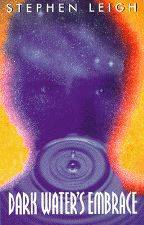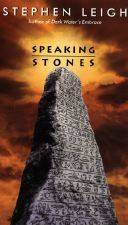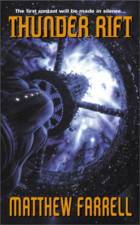

| Stephen Leigh also writes under the pseudonyms "Matthew Farrell" and "S. L. Farrell". He has his own Web page. | ||
| Click on a book's image or title to order from Amazon.com |

Dark Water's Embrace
Avon/EOS, PB, © 1998, 325 pp, ISBN #0-380-79478-0Reviewed April 1998
Dark Water's Embrace is a dark, chilling story of a colony of humans trying to survive with a very low initial gene pool (eight people) on an alien world which is inducing a high mutation rate among its resident races. You might think this latter would be a good thing, but it's not, necessarily, because mutation tends to work through trial-and-error, with a lot more errors than successes, and when your colony only numbers about a hundred people, this is not a good thing.
A hundred years after the founding of the colony on Mictlan, Anais Koda-Levin is a young woman who also has "mild-to-moderate hermaphoditism", and she's the heir apparent to the colony's doctor. Unable to become pregnant (one of the main responsibilities of women in this endangered colony), she finds herself become more ostracized over time, and the object of hatred of some of the colony's elders. Moreover, she had a relationship with another woman sometime earlier - a woman who later died in childbirth - which is regarded as taboo since it potentially removes women from the breeding pool. One of the colony's founders, Gabriela Rusack, was a lesbian who refused to bear children after the catastrophe that killed all the founders except for herself and the other eight, and she was eventually cast out of the colony altogether.
Then, a body is found in a nearby bog, a body of one of the Miccail, Mictlan's native sentient race which died out fairly suddenly a thousand years earlier. Anais' examinations reveal that it was an hermaphrodite as well, and that it seemingly served a purpose in the Miccail's reproductive cycle.
The books unfolds on several levels: Anais discovered that her hermaphroditism is not perhaps so "mild" after all, and the position this places her in in the colony is revealed through the eyes of herself and several of her friends, companions, and adversaries. We also learn some of what Gabriela Rusack went through in her day on Mictlan, as well as a little about who the Miccail were, how their society was structured, and what happened to it. The storytelling approach is tremendously effective, revealing a great deal of information (thus avoiding reader frustration) while building suspense where necessary. The grim circumstances of the colony are brilliantly portrayed in the first half of the book, for instance, and the plot all ties together as the book draws to a close.
Leigh does a great job creating his world and its background while creating a tense, personal atmosphere among the colonists and never letting up on the suspense and the very real dangers that Mictlan presents to the humans until the mysteries are resolved. Anais' dilemmas and traumas are especially well-rendered, and full of sexual tension (both positive and negative).
In my judgment, this book certainly deserves some consideration for the James Tiptree Jr. Award, but regardless of that, it's a must-read novel.

Speaking Stones
Avon/EOS, PB, © 1999, 330 pp, ISBN #0-380-79914-6Reviewed May 1999
Speaking Stones is the sequel to Dark Water's Embrace, taking place on the planet Mictlan a hundred years after the first book. Leigh broadly categorized the first novel as dealing with sex and reproduction, and the second as dealing with racial/species prejudice.
In Speaking Stones, the "midmales" - hermaphrodites whose sexual function is to purify the male genetic material before fertilization - have evolved among the human colony on Mictlan. The Sa, as they call themselves, have taken up residence on the island which was the traditional home of the Sa for the Miccail - the native species of the planet which had seemingly died out a thousand years ago. While many humans have accepted the Sa as part of their life on this new world, many others regard the Sa as abomination and shun them. To top it off, it turns out that the Miccail have not actually died out, they had merely regressed to near the level of animals, and now have regained some of their culture and do not care for the human invaders starting the spread across their world.
The plot begins when a young Sa, Fianya, is entrusted to the care of some humans in the Rock, the first settlement of the human colonists. Fianya disappears one day, and eventually turns up murdered, and it's not clear who the killers are: Anti-Sa humans, Miccail, or someone else? The spiritually-driven leader of the Sa assigns Caitlyn - a Sa who has as yet done little to distinguish kerself among ker fellows - to investigate on behalf of the Sa.
Speaking Stones doesn't live up to its predecessor, and the main reason for this is that it really needed one new, meaty science fictional idea. Instead, it builds exclusively on what has gone before, and ends up being a fairly straightforward political drama, with a difficult romance between Caitlyn and a woman from the Rock, Ishiko Allen-Shimmura, in the midst of it.
The primary focus of the book is on the relationship between the male/female humans and the Sa. The elderly leader of the Allen-Shimmura clan, a woman named Euzhan, was present in the first book, and has come to hate the Sa, and forbids her clan to have anything to do with them. She fills the role of the can't-be-reasoned-with force around which Ishiko and Caitlyn have to work - in more ways than one. Euzhan also hates the Miccail, and her standing with the council governing the humans gives her great power to shape their actions. Her opposite number among the Miccail, CosTa, leader of the fanatical Quali'Ka, is only slightly easier to reason with, but she has sound reasons to be distrustful of the humans, given how they've treated the Miccail.
(Actually, I was rather taken aback that the Miccail had recovered enough in a hundred years to be a powerful social force on the planet, since it seemed from Embrace that they really had become little more than animals. I never quite figured out how they recovered to the extent that they did, and this was a constant distraction for me through the book.)
The bulk of Stones involves the machinations of the characters as the story builds to its final confrontation, when the Quali'Ka decide to attack the humans in an attempt to wipe them out, which leads to a fairly impressive scene when the artificial intelligence controlling the remnants of the orbiting ship which brought the colonists there, decides to take a hand in the situation. The sequence is slightly reminiscent of the collapsing space elevator sequence in Kim Stanley Robinson's Red Mars. But, it's really too little too late for this story.
Overall, Speaking Stones is an entertaining read, but substantially less intriguing than its predecessor, and therefore quite a disappointment to me.

Thunder Rift
Avon/EOS, PB, © 2001, 373 pp, ISBN #0-380-79915-4Reviewed September 2001
Thunder Rift (written under the pseudonym "Matthew Farrell") is an offbeat novel of first contact. In 2061, "Thunder", a wormhole, opens in the outer solar system, and the radiation erupting from it disrupts all electronics on Earth, plunging the planet into a lengthy depression. Thirty years later, humanity launches its first manned mission through the wormhole, a mainly military mission with a few civilian staff, including Taria Spears, a woman obsessed with Thunder since her mother was accidentally killed in China when she was a child. On the far side of the wormhole they find a stellar system with a planet orbiting a gas giant, with a sparse, pre-technological population termed "Blues" by the ship.
Although the ship's primary mission is to find the "Makers" of the wormhole, and although she's not well-liked by the ship's military crew, Taria convinces Commander Allison, her division head, to allow her to go down to the planet and live with the Blues. She finds a race with hazy, myopic vision, a wide vocal range, exquisite hearing, and multiple languages employed for different purposes. Strangely, the entire culture seems to adhere to the same religion, involving the creator of the world.
Taria befriends a "priestess", Makes-the-Sound-of-East-Wind, and embarks on a voyage of discovery of this strange world, its culture, and the secrets which the ship didn't imagine the planet held when it came through the rift.
Thunder Rift, successfully avoids being a routine "first contact" novel, and despite appearances it doesn't really strive to be a grand "exploring the mysteries of the universe" novel (a la Alastair Reynolds' Revelation Space). At its core, it's a novel of culture clash and how difficult it is for members of one culture to understand a different culture completely independent of it, and of course Farrell throws on top of this the fact that not only are the Blues' languages different from our own, but their method of vocalizing is also different.
The style of the storytelling is that of, "all the clues are there, if only you know to look for them": Despite the linguistic difficulties, Makes shows Taria a great many things, including the lovely Watersingers and their overpowering but no less alluring "cousins", the Greater Singers, both of whom live in the water. Makes' "order" seems to be presided over by someone called the Neritorika, and the cities are guarded by kagliaristi, who are all male, and can resolve disputes among cities through ritual combat. The Blues are willing to allow Taria - but only Taria - to come live with them, and threaten vague consequences if others come uninvited. And Makes' position seems to be due to Thunder opening at the time of her confirmation.
It's implicitly clear from the outset that Taria's adventure will also be tied into the mystery of the Makers, since Farrell never really suggests that the truth lies elsewhere. The success of the story hinges primarily on the plausibility of Blue culture, and it succeeds as far as it goes, although the view of their culture which we get is, like the Blues themselves, somewhat myopic: Taria only directly interacts with a few Blues, and is kept at arm's reach (so to speak) of the rest. So the story does end up being something of a "peeling back the layers of the mystery" yarn, feeling less intricate than it might.
My big disappointment was with the book's climax, though: Although it did make sense overall, I was a bit annoyed that it relies in part on the introduction of "powers man can't truly understand", and I also felt let down by the resolution of some of the character threads. Even aside from the fate of one of the main characters, I felt that more needed to be said about the reaction of the other characters to the closing events of the story. The ending felt abrupt in that way.
In summary, Thunder Rift is an extremely ambitious novel, and it's probably not surprising that it succeeds in some ways, and doesn't work so well in others. It's an enjoyable book, but it felt like there should have been more to it.
hits since 13 August 2000.